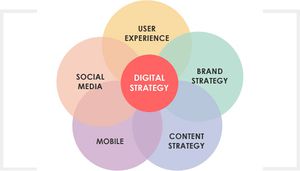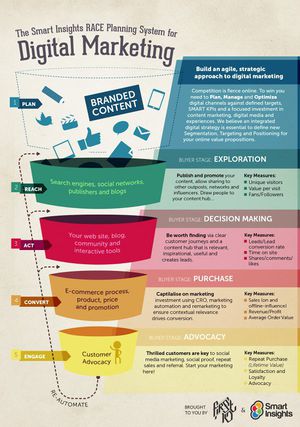Digital Strategy
What is Digital Strategy?
Digital Strategy is the process of specifying an organization's vision, goals, opportunities, and related activities in order to maximize the business benefits of digital initiatives to the organization. These can range from an enterprise focus, which considers the broader opportunities and risks that digital potentially creates (e.g., changes in the publishing industry) and often includes customer intelligence, collaboration, new product/market exploration, sales, and service optimization, enterprise technology architectures and processes, innovation, and governance; to more marketing and customer-focused efforts such as web sites, mobile, eCommerce, social, site and search engine optimization, and advertising.[1]
Digital Strategy is not IT Strategy, and requires a different approach. Going mobile, adding analytics, or extending the online experience begs the question what’s next? These investments often changed the form of interaction, with limited change to the function. Transforming the business with digital, particularly in the marketing area, makes sense in the face of changing consumer expectations, options, and information. As organizations near the end of their first digital journey and complete their initial roadmap, the question of digital strategy re-joins the executive agenda.
What should be different in digital strategy? This is the first question to ask when revisiting this topic. Repeating the past is no guarantee of success, so understanding the directions for digital strategy is important. At the highest level, there are two options available.
The first option calls for extending digitization by repeating the current digital playbook to cover new functions and processes. That is the path IT took as it automated and integrated functions across the organization. Starting with ERP, the strategy repeated itself for customer relationship management, supply chain, sales force, product development, and other functions. Digitizing HR, Financial Management, and other functions provide examples of strategies based on applying new technology to existing activity.
Transforming activity, and therefore the business, is the second option for digital strategy. This was an initial promise of first-generation digital strategies but one that often fell back into prior IT Transformation habits in the face of organizational, governance, and other legacy roadblocks. Taking this path recognizes the work that has been done but asks the question – should the digital strategy be more of the same or can it be different? It is an important distinction and a question that requires a thoughtful response.[2]
The Need for a Digital Strategy[3]
- A digital strategy allows one to unify different channels under coherent objectives. It also helps keep offline and online approaches consistent, meaning that a unified output is presented to customers. A strategy allows one to plan your channel activity, and plan the points where they cross over. Once it is worked out how your channels are going to be used to supplement each other, the marketing activity as a whole becomes a more refined machine. This could mean fewer waste resources, or missed out opportunities to use one channel to boost output from another.
- Secondly, a strategy allows for informed judgments about one's success. By having clearly defined objectives and target audiences, as well as the right tools and methods for collecting data, one can look at numbers that tell how a campaign is going – rather than basing assessments on personal opinion. Having KPIs and benchmarks to follow means that one has a measurable standard for what success looks like.
The Importance of a Digital Strategy[4]
The rapid pace of consumer adoption of digital platforms has taken most organizations by surprise. In many ‘digital’ has been, until recently, a relatively minor offshoot of the marketing department. Suddenly it is a C-Suite priority. Gartner recently reported that over half of the firms in their CEO survey have some sort of digital strategy. Many others reported that they were working on one or knew they needed one – so the digital strategy is clearly important for a wide range of organizations.
Many now believe an effective digital strategy is mission-critical for most organizations, in the recent MIT Management School report Embracing Digital Technology they went so far as to say:
“Companies now face a digital imperative: adopt new technologies effectively or face competitive obsolescence. While there is consensus on the importance of adopting digital technology, most employees find the process complex and slow. Many say their leaders lack urgency and fail to share a vision for how technology can change the business. Companies that succeed tend to have leaders who share their vision and define a road map, create cross-organizational authority for adoption, and reward employees for working towards it.”
These are far from isolated opinions, many organizations and the consultancies they work with now consider a coherent digital strategy a significant driver of competitive advantage and therefore a key strategic priority.
Key Steps to Developing a Digital Strategy[5]
- Plan and Assess
- Create and Launch
- Choose the Right Platforms
- Engage and Cultivate
- Measure and Evaluate
An Integrated Digital Strategy

source: DreamConsultany
Digital Strategy Framework[6]
In his books on Digital Marketing, Dave Chaffey of SmartInsights.com features the RACE framework for creating and managing a Digital Strategy. The idea behind RACE is to provide a simple structure for companies to develop a digital plan which meets the challenges of reaching and engaging online audiences to prompt conversion to online or offline sales.
RACE consists of these four steps or online marketing activities designed to help brands engage their customers throughout the customer life-cycle.
- REACH: Reach involves building awareness of a brand, its products, and services on other websites and in offline media in order to build traffic by driving visits to different web presences like your main site, micro-sites, or social media pages. It involves maximizing reach over time to create multiple interactions using different paid, owned, and earned media touchpoints.
- ACT: Act is short for Interact. It's a separate stage since encouraging interactions on websites and social media to generate leads is a big challenge for online marketers. It's about persuading site visitors or prospects to take the next step, the next Action on their journey when they initially reach your site or social network presence. For many types of businesses, especially, Business-to-Business, this means generating leads, but it may mean finding out more about a company or its products, searching to find a product, or reading a blog post. You should define these actions as top-level goals of the funnel in analytics. Google Analytics Goals can include "Viewed product", "Added to Basket", "Registered as a member" or "Signed up for an e-newsletter. Act is also about encouraging participation. This can be sharing of content via social media or customer reviews (strictly, part of Engage). The specific goals and dashboard need to be defined for each business as explained in our Delivering results from digital marketing guide. It's about engaging the audience through relevant, compelling content and clear navigation pathways so that they don't hit the back button. The bounce rate on many sites is greater than 50%, so getting the audience to act or participate is a major challenge which is why we have identified it separately.
- CONVERT: This is conversion to sale. It involves getting your audience to take that vital next step which turns them into paying customers whether the payment is taken through online eCommerce transactions or offline channels.
- ENGAGE: This is a long-term engagement that is, developing a long-term relationship with first-time buyers to build customer loyalty as repeat purchases using communications on your site, social presence, email, and direct interactions to boost customer lifetime value. It can be measured by repeat actions such as repeat sales and sharing content through social media. We also need to measure the percentage of active customers (or email subscribers) and customer satisfaction and recommendation using other systems.
RACE is an evolution of the REAN (Reach > Engage > Activate > Nurture) framework for web analysis originally developed by Xavier Blanc and popularised by Steve Jackson in his book Cult of Analytics.
RACE Digital Strategy Funnel

source: SmartInsights
The REAN Model[7]
REAN is a marketing acronym first coined by Xavier Blanc in 2006 while working for a Finnish digital marketing agency. It was further developed by Steve Jackson for web analytics. The information on this page is offered as a resource to our customers for a better understanding of how to use Knock Knock analytic information. REAN can be used for measuring business website statistics. It gives well-defined and concrete terms that can be measured and acted on. Good website marketing strategies can be developed using the REAN principles.
- Reach: defines the methods to attract people to one's promotions. What is the best source of traffic by volume or cost? There are a number of ways one can reach out to customers that are measurable. Search keywords in Google, Pay Per Click, links on other websites, email promotions, newspaper promotions, flyers, etc. All of these are measurable with web analytics. Each one can have a specific entry page or key id associated with it and can be tracked individually.
- Engage: is how people interact with one's website. What processes do they complete or abandon, and how long do they stay? Engagement involves the tracking of visitors once they enter one's website. One might think of this as a funneling process to direct visitors to a goal page or action. There are different measurements for engagement such as Click-depth, the number of pages a visitor will select, and Duration, the length of time on your website.
- Activate: means a visitor has taken an action, i.e. maybe a purchase, sign-up, etc. Activation occurs when a visitor acts in the manner that is desired. This could be making a purchase, filling in a form for more information, signing up for an emailing list, reaching a goal page, etc.
- Nurture: describes the method of retaining and re-engaging with customers who have already taken an action. This occurs after an Activation has happened. This might be newsletters, emailing lists for special promotions, community membership, etc.
See Also
References
- ↑ Digital Strategy Definition
- ↑ https://www.accenture.com/us-en/blogs/blogs-digital-what-is-digital-strategy What is Digital Strategy?]
- ↑ Digital Strategy – What It Is & Why You Need One
- ↑ Digital Strategy - a strategic priority
- ↑ How to Develop Your Digital Strategy?
- ↑ Strategy Framework
- ↑ The REAN model - Reach, Engage, Activate and Nurture
